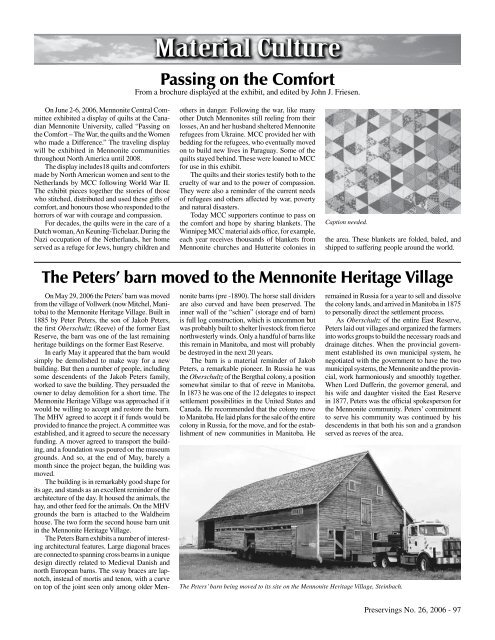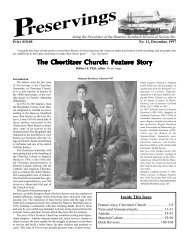Preservings $20 Issue No. 26, 2006 - Home at Plett Foundation
Preservings $20 Issue No. 26, 2006 - Home at Plett Foundation
Preservings $20 Issue No. 26, 2006 - Home at Plett Foundation
You also want an ePaper? Increase the reach of your titles
YUMPU automatically turns print PDFs into web optimized ePapers that Google loves.
M<strong>at</strong>erial Culture<br />
Passing on the Comfort<br />
From a brochure displayed <strong>at</strong> the exhibit, and edited by John J. Friesen.<br />
On June 2-6, <strong>2006</strong>, Mennonite Central Committee<br />
exhibited a display of quilts <strong>at</strong> the Canadian<br />
Mennonite University, called “Passing on<br />
the Comfort – The War, the quilts and the Women<br />
who made a Difference.” The traveling display<br />
will be exhibited in Mennonite communities<br />
throughout <strong>No</strong>rth America until 2008.<br />
The display includes18 quilts and comforters<br />
made by <strong>No</strong>rth American women and sent to the<br />
Netherlands by MCC following World War II.<br />
The exhibit pieces together the stories of those<br />
who stitched, distributed and used these gifts of<br />
comfort, and honours those who responded to the<br />
horrors of war with courage and compassion.<br />
For decades, the quilts were in the care of a<br />
Dutch woman, An Keuning-Tichelaar. During the<br />
Nazi occup<strong>at</strong>ion of the Netherlands, her home<br />
served as a refuge for Jews, hungry children and<br />
others in danger. Following the war, like many<br />
other Dutch Mennonites still reeling from their<br />
losses, An and her husband sheltered Mennonite<br />
refugees from Ukraine. MCC provided her with<br />
bedding for the refugees, who eventually moved<br />
on to build new lives in Paraguay. Some of the<br />
quilts stayed behind. These were loaned to MCC<br />
for use in this exhibit.<br />
The quilts and their stories testify both to the<br />
cruelty of war and to the power of compassion.<br />
They were also a reminder of the current needs<br />
of refugees and others affected by war, poverty<br />
and n<strong>at</strong>ural disasters.<br />
Today MCC supporters continue to pass on<br />
the comfort and hope by sharing blankets. The<br />
Winnipeg MCC m<strong>at</strong>erial aids office, for example,<br />
each year receives thousands of blankets from<br />
Mennonite churches and Hutterite colonies in<br />
Caption needed.<br />
the area. These blankets are folded, baled, and<br />
shipped to suffering people around the world.<br />
The Peters’ barn moved to the Mennonite Heritage Village<br />
On May 29, <strong>2006</strong> the Peters’ barn was moved<br />
from the village of Vollwerk (now Mitchel, Manitoba)<br />
to the Mennonite Heritage Village. Built in<br />
1885 by Peter Peters, the son of Jakob Peters,<br />
the first Oberschultz (Reeve) of the former East<br />
Reserve, the barn was one of the last remaining<br />
heritage buildings on the former East Reserve.<br />
In early May it appeared th<strong>at</strong> the barn would<br />
simply be demolished to make way for a new<br />
building. But then a number of people, including<br />
some descendents of the Jakob Peters family,<br />
worked to save the building. They persuaded the<br />
owner to delay demolition for a short time. The<br />
Mennonite Heritage Village was approached if it<br />
would be willing to accept and restore the barn.<br />
The MHV agreed to accept it if funds would be<br />
provided to finance the project. A committee was<br />
established, and it agreed to secure the necessary<br />
funding. A mover agreed to transport the building,<br />
and a found<strong>at</strong>ion was poured on the museum<br />
grounds. And so, <strong>at</strong> the end of May, barely a<br />
month since the project began, the building was<br />
moved.<br />
The building is in remarkably good shape for<br />
its age, and stands as an excellent reminder of the<br />
architecture of the day. It housed the animals, the<br />
hay, and other feed for the animals. On the MHV<br />
grounds the barn is <strong>at</strong>tached to the Waldheim<br />
house. The two form the second house barn unit<br />
in the Mennonite Heritage Village.<br />
The Peters Barn exhibits a number of interesting<br />
architectural fe<strong>at</strong>ures. Large diagonal braces<br />
are connected to spanning cross beams in a unique<br />
design directly rel<strong>at</strong>ed to Medieval Danish and<br />
north European barns. The sway braces are lapnotch,<br />
instead of mortis and tenon, with a curve<br />
on top of the joint seen only among older Mennonite<br />
barns (pre -1890). The horse stall dividers<br />
are also curved and have been preserved. The<br />
inner wall of the “schien” (storage end of barn)<br />
is full log construction, which is uncommon but<br />
was probably built to shelter livestock from fierce<br />
northwesterly winds. Only a handful of barns like<br />
this remain in Manitoba, and most will probably<br />
be destroyed in the next 20 years.<br />
The barn is a m<strong>at</strong>erial reminder of Jakob<br />
Peters, a remarkable pioneer. In Russia he was<br />
the Oberschultz of the Bergthal colony, a position<br />
somewh<strong>at</strong> similar to th<strong>at</strong> of reeve in Manitoba.<br />
In 1873 he was one of the 12 deleg<strong>at</strong>es to inspect<br />
settlement possibilities in the United St<strong>at</strong>es and<br />
Canada. He recommended th<strong>at</strong> the colony move<br />
to Manitoba. He laid plans for the sale of the entire<br />
colony in Russia, for the move, and for the establishment<br />
of new communities in Manitoba. He<br />
remained in Russia for a year to sell and dissolve<br />
the colony lands, and arrived in Manitoba in 1875<br />
to personally direct the settlement process.<br />
As Oberschultz of the entire East Reserve,<br />
Peters laid out villages and organized the farmers<br />
into works groups to build the necessary roads and<br />
drainage ditches. When the provincial government<br />
established its own municipal system, he<br />
negoti<strong>at</strong>ed with the government to have the two<br />
municipal systems, the Mennonite and the provincial,<br />
work harmoniously and smoothly together.<br />
When Lord Dufferin, the governor general, and<br />
his wife and daughter visited the East Reserve<br />
in 1877, Peters was the official spokesperson for<br />
the Mennonite community. Peters’ commitment<br />
to serve his community was continued by his<br />
descendents in th<strong>at</strong> both his son and a grandson<br />
served as reeves of the area.<br />
The Peters’ barn being moved to its site on the Mennonite Heritage Village, Steinbach.<br />
<strong>Preservings</strong> <strong>No</strong>. <strong>26</strong>, <strong>2006</strong> - 97
















